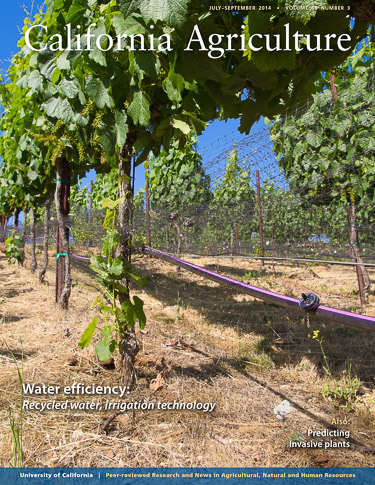All Issues

Water efficiency:
Recycled water, irrigation technology
Cover:
As California enters the third year of an historic drought, with reservoirs at all-time lows and thousands of acres lying fallow, scientists and policymakers are looking for ways to increase water conservation and efficiency across the state. New UC research demonstrates the possibilities and challenges of irrigating crops with recycled wastewater (pages 59, 68, 75) and employing technology to reduce water use in surface-irrigated fields (page 82). Shown is Trinitas Cellars, which has irrigated its 12-acre vineyard in Napa County with recycled water for over seven years. The color purple on the irrigation tubing is used universally to signify recycled or reclaimed water. Photo by Will Suckow
July-September 2014
Volume 68, Number 3
Volume 68, Number 3
News and opinion
UC COOPERATIVE EXTENSION HISTORY
UC COOPERATIVE EXTENSION CENTENNIAL: Irrigation of deciduous orchards and vineyards influenced by plant-soil-water relationships in individual situations
UC COOPERATIVE EXTENSION HISTORY
UC COOPERATIVE EXTENSION CENTENNIAL: Can irrigation with municipal wastewater conserve energy?
UC COOPERATIVE EXTENSION HISTORY
UC COOPERATIVE EXTENSION CENTENNIAL: Improved leaching practices save water, reduce drainage problems
UC COOPERATIVE EXTENSION HISTORY
UC COOPERATIVE EXTENSION CENTENNIAL: Placement of tensiometers as guides to irrigation practices
UC COOPERATIVE EXTENSION HISTORY
UC COOPERATIVE EXTENSION CENTENNIAL: Eucalyptus fuel dynamics, and fire hazard in the Oakland hills





